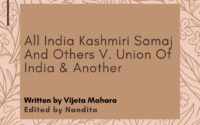The Rule of Best Evidence in Criminal Jurisprudence
This Article has been written by RIYA KAUSHIK studying LL.B. in GEETA INSTITUTE OF LAW and Curated by NAMAN JAIN of Bennett University.
Evidence is a fact, sign, or a document that makes us believe that something is real. The Law of Evidence is also known as the Rule of Evidence. These are the rules or legal principles which govern the proof of facts in legal proceedings. These are also related to the type of evidence. These pieces of evidence are quantum or quality, which is required to prove the facts in litigation. The rules vary from court to court, i.e., whether it is a Criminal Court, Civil Court or Family Court, and the Jurisdiction of the Court.
The Rule of Best Evidence is a Legal principle that holds that the original document is a superior Evidence. It holds that the copy of the original document is not admissible if an original document exists and can be obtained. The rule has its roots in 18th century British Law. It states that as long as you have a piece of superior evidence to prove it, no inferior evidence will be presented before the court.
The Rule of Best Evidence is the foundation of the criminal justice system. This Rule has great importance in criminal trials. An accused is considered innocent until proven guilty, and the guilt of the accused has to be proved beyond a reasonable doubt on the basis of Best Possible Evidence and not on the basis of hypothetical arguments.
The Best Evidence Rule is the preference of courts, which includes original writings, recordings, and photographs rather than its copies. Copies work a secondary source when the facts have to be proved, whereas the purpose of the Best Evidence Rule is to avoid potential accuracy, which can be present in Handmade copies.
The question to be considered is that why a Secondary Source should be used as evidence when at the same time, Original Evidence is available or can be accessed?
The Hon’ble Supreme Court, in the case of Roop Kumar V. Mohan Thedani, held that “admitting inferior evidence when the law requires superior evidence, would amount to nullifying the law.”
In India, the Best Evidence Rule is regarded as the Fundamental Principle upon which The Law of Evidence is based. Although the Best Evidence Rule is not explicitly mentioned in the Indian Evidence Act 1872, S. 91 & 92 of the IEA provides the base for it.
- 91 of the IEA states that the original document should be produced for proving the contents related to contracts, grants, or other dispositions. However, it does not prohibit to adduce some evidence in a case; the deed is capable of being construed in a different way, which is understandable. Further, S. 92 excludes the evidence of oral agreements.
Over a period, this Rule has faced many practical limitations on obtaining and producing the original copy of the document. Nowadays, most of the information is stored through electronic devices, and the original copy of it is the hardcopy of the same. If the litigant wants to present them in a court, then to satisfy the Rule, he must produce the original printout copy to the court; however, its authenticity is questionable.
The exceptions to this Rule are-
- When the original documents are destroyed or lost.
- When it is not possible to produce the original copy by any means.
- When the original document is in the hold of the party against whom it has to be used.
- When the writing, recording, or photograph is not closely related to the controlling issue in the case.
Once the party shows that any of the exceptions discussed above is applicable in their case, then the secondary evidence can be used.
The court has the discretion to refuse the applicability of this Rule when no meaningful purpose of producing the original evidence is found.
The Best Evidence Rule should not be used as a rigid option, however, it should be used as a guide to choose the appropriate method of proof. Its applicability should be based on the nature of the case.
In criminal cases, the necessity of the circumstances must be proven based on absolute facts and evidence. Any failure in producing the best evidence makes the prosecution vulnerable to an adverse inference being drawn against it. Moreover, it can lead to injustice, which can only be avoided if the Best Evidence is available. The Rule does not apply only to the written documents but also to oral testimonies and witnesses. Thus, the advocates must produce the best possible evidence to establish the case against the wrongdoer, and any failure to it can make the proceedings doubtful and can lead to injustice.


